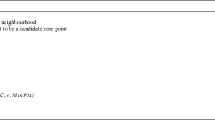Abstract
GIS is a subject with multi-disciplinary applications, ranging from military applications, weather forecasting, recognizing biodiversity prone regions to hotspot identification for socio-economic purposes. The main focus of the work is identification of neighboring tourist hot spots based on the Compact Coalescence Clustering Algorithm (C3A). In order to achieve this goal, firstly various tourist spots, along with the major cities and towns are identified (digitized) and based on the proposed clustering algorithm, which actually works in two phases, various existing clusters of neighborhood tourist hot spots are generated. In the first phase of the process using Clustering of Noisy Regions (CNR), several clusters of tourist spots are formed based on certain threshold distance value and accordingly the centroid is computed and updated every time the cluster is expanded. The soft clustering approach Fuzzy C-Means (FCM) is applied on the result produced in order to enhance the compactness of the clusters formed. Furthermore, the location of the tourist spots neighborhood to major cities and towns are displayed graphically on the map.
Similar content being viewed by others
References
Anirban Chakraborty, J.K. Mandal, Pallavi Roy, Pratyusha Bhattacharya, Clustering of Noisy Regions (CNR)—A GIS Anchored Technique for Clustering on Raster Map, Proceeding 2nd International Conference on Computer and Communication Technologies (IC3T 2015), pp. 511–520, Springer AISC, Volume 381, 2016.
James C. Bezdek, Robert Ehrlich, and William Full, “FCM: The Fuzzy c-Means Clustering Algorithm”, Computers and Geosciences Vol. 10, No. 2–3, pp. 191–203, May 1984.
Anirban Chakraborty, J.K. Mandal, S.B. Chandrabanshi, S. Sarkar, A GIS Anchored system for selection of utility service stations trough k-means Method of Clustering, Conference Proceedings “Second International Conference on Computing and Systems (ICCS-2013)”, ISBN 978-9-35-134273-1, McGraw Hill Education (India) Private Limited, pp. 244–251, 21–22 September, 2013.
Anirban Chakraborty, J.K. Mandal, A GIS Anchored system for clustering discrete data points—a connected graph based approach, Emerging ICT for Bridging the Future-Volume 1, Advances in Intelligent Systems and Computing 337, Springer International Publishing, Switzerland, DOI:10.1007/978-3-319-13728-5_5, pp. 43–51, December 2014.
Anirban Chakraborty, J.K. Mandal, Arun Kumar Chakraborti, A File base GIS Anchored Information Retrieval Scheme (FBGISIRS) through Vectorization of Raster Map, International Journal of Advanced Research in Computer Science, ISSN No. 0976-5697 volume-2 No. 4, pp. 132–138, July–August 2011.
http://www.tutorialspoint.com/java/index.htm, accessed on 14 September, 2013.
http://www.zetcode.com/tutorials/javaswingtutorial, accessed on 14 February, 2015.
https://netbeans.org/kb/docs/java/javase-intro.html, accessed on 14 February, 2015.
Bhavani Raskutti and Christopher Leckie, An Evaluation of Criteria for Measuring the Quality of Clusters, IJCAI Proceedings of the 16th International Joint Conference on Artificial Intelligence, Volume 2, Morgan Kaufman Publishers Inc., San Francisco, pp. 905–910, 1999.
Acknowledgments
The authors express a deep sense of gratitude to the Department of Computer Science, Barrackpore Rastraguru Surendranath College, Kolkata-700 120, India and Department of Computer Science and Engineering, University of Kalyani for providing necessary infrastructural support for the work.
Author information
Authors and Affiliations
Corresponding author
Editor information
Editors and Affiliations
Rights and permissions
Copyright information
© 2016 Springer India
About this paper
Cite this paper
Chakraborty, A., Mandal, J.K., Roy, P., Bhattacharya, P. (2016). Compact Coalescence Clustering Algorithm (C3A)—A GIS Anchored Approach of Clustering Discrete Points. In: Satapathy, S.C., Mandal, J.K., Udgata, S.K., Bhateja, V. (eds) Information Systems Design and Intelligent Applications. Advances in Intelligent Systems and Computing, vol 434. Springer, New Delhi. https://doi.org/10.1007/978-81-322-2752-6_50
Download citation
DOI: https://doi.org/10.1007/978-81-322-2752-6_50
Published:
Publisher Name: Springer, New Delhi
Print ISBN: 978-81-322-2750-2
Online ISBN: 978-81-322-2752-6
eBook Packages: EngineeringEngineering (R0)




